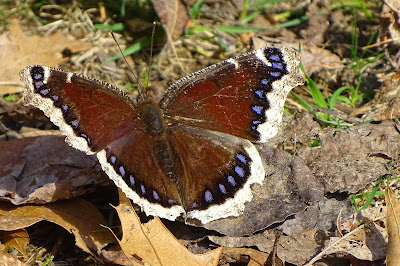Spring evenings, strolling down the path into Halibut Point
State Park you're going to be greeted by the peeper frog chorus promoting
procreation in wetlands everywhere. Occasionally out of the blackness may come
a quacking sound, to my ear more like a crow mutter, indicating wood frogs.
That justifies a call to the Cape Ann Vernal Pond Team (CAVT).
CAVT members Rick Roth and Martin Basch came out to see
about certifying possible vernal pools. I wasn't sure how their walking sticks
fit into the outing since the first pool was only a couple of hundred feet up
the path.
 |
Confronting cat brier
and sudden depth drops
|
Rick uses the stick as a depth gauge, and to part the cat
brier. From experience he attests that it's better to try to find the bottom
with his stick than his body. This is quarry country where water holes can be
deep.
Rick wears polarizing sunglasses to help spot amphibian egg
masses below the water surface. He collects them onto a floating tray.
 |
Spotted salamander
egg mass attached to twigs in pond
|
Photographic evidence of five egg masses suffices to certify
a vernal pool. Since most of the parent species are nocturnal, finding the egg
masses in the daytime is an "easier" way to provide evidence. But day
or night, all CAVT expeditions are spectacular.
 |
Five qualifying
salamander samples
|
After being photographed the egg masses are returned to the
pond to develop into larvae with gills. Like all amphibians salamanders eventually
develop lungs for their terrestrial adult life. They can succeed if the pool retains
water long enough, at least a couple of months, for the youngsters to get legs
and crawl off into the forest.
Life in this niche avoids fish predation. By definition
vernal pools preclude fish because they lack moving water from inlets or
outlets, and they dry up seasonally. 'Vernal' means 'spring.'
 |
Martin Basch taking a
GPS reading
|
GPS coordinates locate the pool within twenty feet for a map
maintained by the Department of Fisheries and Wildlife. Certified pools receive
State protection of a 25-foot buffer zone, which may be enlarged by local
ordinance. Rockport voters have authorized a 50-foot buffer. All of this
differs from areas designated wetlands by the Department of Environmental
Management with more stringent rules and usage implications, which typically
don't apply to vernal pools.
Most vernal pools are tiny, but Rick believes they feed more
forest wildlife than any other wetland. The high mortality rate of eggs and
newborns means that creatures higher up the food chain are feasting.
Vernal pools are also defined by the presence of 'obligate' species, creatures such as
salamanders and wood frogs that breed nowhere else. Peepers, because they breed
in many kinds of wetlands, are often present in vernal pools are not specific indicators. Peepers reproduce with a
different strategy, laying singular eggs that drop into the muck bottom to
avoid detection while they gestate.
On another occasion Rick highlighted the allure of the hunt,
the vibrancy of a forest night in spring and the mostly unseen relationships
that briefly come into focus.
 |
Yellow-spotted
salamanders swimming
|
"I'm a salamander guy. To me it's just totally
normal....This is ultimately about the health of the planet. To me, it's just
makes perfect sense that not only is there this wonderful thing called Nature
that includes all these delightful plants and animals but it's also necessary.
So to me it's not eccentric at all."
"Look at all these people showing up on a rainy night,
and with kids! What's going on? It's a vernal pond field trip!"











































